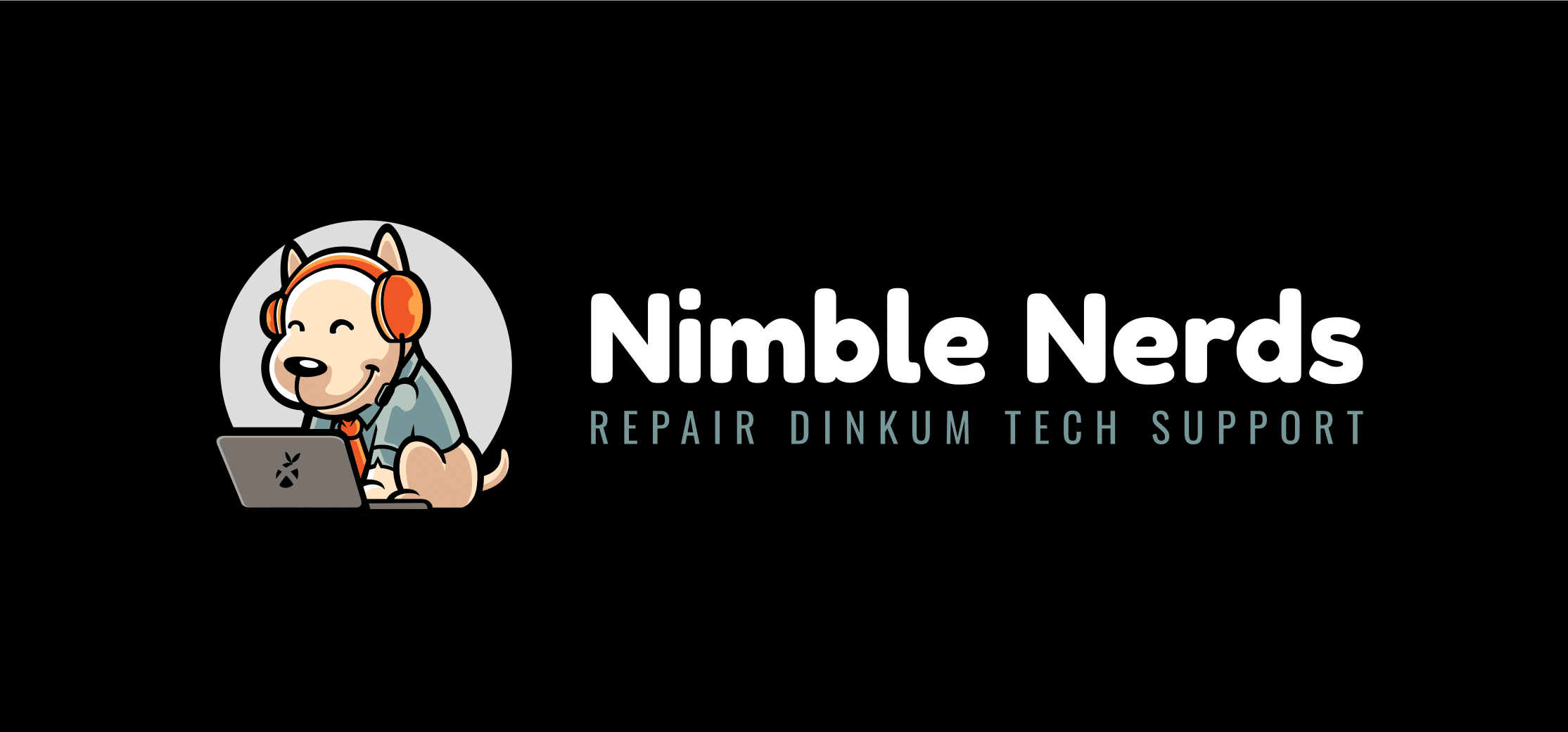Software Troubleshooting: Solving Common Software Issues
Troubleshooting software issues can sometimes feel overwhelming, especially when unexpected errors pop up and disrupt your work. Fret not—Nimble Nerds is here to lend a hand! Our team is here to save the day if you encounter error messages or complex system crashes.
We’ll ensure a tech expert reaches out to you within 30 minutes of your initial enquiry to our friendly reception without any obligations so you can get back on track as easily as possible. Let’s explore some troubleshooting tips and methods that will give you the confidence to address software program issues effectively.
20+ Years In Business
No Same Day Surcharges
Rapid Response Times
Tailored Tech Solutions
Guaranteed Satisfaction
It's Been A Privilege To Support:










Every Job: Planting Seeds, Uplifting Lives:
Trees planted w/ Greenfleet, TeamTrees & Dragon Dreamers
App not opening? Constant crashes or weird popups? We troubleshoot all types of software issues quickly and clearly — no jargon, no stress.
Get Expert Software Support Now
Understanding Software Troubleshooting
If you’ve ever experienced a program freezing at the worst time, I’m sure you understand the frustration of software glitches. While troubleshooting software isn’t limited to tech experts—it’s a skill that anyone can acquire.
In general, software troubleshooting involves identifying, diagnosing, and resolving issues that arise on your computer. Picture yourself as a detective for your PC. The initial step in any investigation is determining what’s causing the problem. The software can exhibit issues, such as displaying error messages, crashing, freezing, or running sluggishly and understanding the issue at hand aids in pinpointing the cause.
Common software problems include applications abruptly closing (we’ve all felt annoyed when Word crashes), programs taking an eternity to load, or encountering that dreaded spinning wheel of doom that makes you want to pull your hair out.
Many of these issues arise from either a breakdown in communication between your software and operating system or clashes between programs vying for the resources.
Now, don’t be intimidated by terms. Phrases like “error messages” or “troubleshooting process” mean “identifying what’s wrong and fixing it.” When an error message pops up, your computer drops hints—like a trail of breadcrumbs guiding you towards the solution. But once you get the hang of it, spotting these patterns becomes natural.
Dealing with a software problem may appear overwhelming at first. But mastering troubleshooting is truly gratifying. Not only does it spare you from the annoyance of a computer issue, but it also empowers you to take charge of your technology. Moreover, you feel accomplished when you finally resolve a problem.
Excited to move on to the stage? Let’s discuss the troubleshooting steps to address 90% of the challenges.
Basic Steps in Software Troubleshooting
When dealing with software issues, starting with the basics is always a good idea. Taking a moment to assess the situation saves you time and frustration. For starters, think about any recent changes to your system. Have you recently installed software or updated your operating system? Sometimes, even small changes can cause similar problems with your software.
Another simple but effective step is to restart your system. Although it may seem easy, you’d be surprised how often this simple action can resolve common problems. Restarting clears out data, resets your machine, and fixes everything from crashes to glitches.
If a reboot doesn’t solve the problem, the next thing to do is check for error messages. Moreover, these messages are like signals from your computers asking for help. Although they seem overwhelming at first, but don’t worry. Just make a note of any codes or phrases. Do an online search for solutions.
It’s like having a reference guide for fixing issues.
Another important thing to consider is your hardware connections. It’s easy to overlook. Sometimes, the issue lies with the hardware rather than the software. If your computer isn’t receiving power due to a power cable or cord, no troubleshooting on the software side will resolve it. It’s always an idea to ensure the power cord is securely plugged in before delving.
These simple steps may appear basic, but believe me—they can address a portion of the problems you might face. If you’ve followed these steps and are still encountering difficulties, it could be time to explore troubleshooting methods, which we’ll discuss next.


Advanced Software Troubleshooting Techniques
Alright, so you’ve tried troubleshooting. However, the problem is still lingering like a guest. This is when we need to dig and do some detective work. When the usual fixes aren’t working, it’s time to delve further into how your systems function.
Task Manager
The Task Manager is one of my go-to tools when I encounter situations like this. You can open it by pressing Ctrl + Shift + Esc. It’s like having a backstage pass to see everything your computer’s up to. In the Processes tab, you can check which other programs are running and how much of your system’s resources they use. If you notice an app consuming all the CPU or memory, you might have found the root cause. Eventually, just ending that process can give your system some breathing room.
Safe Mode
Another useful tool in your toolkit is Mode. Booting up your computer in Safe Mode launches it with programs and drivers—essentially starting fresh. This can help you determine if the issue lies with a third-party app or service that activates during startup. If things run smoothly in Safe Mode, it strongly suggests that one of those programs is causing trouble.
Let’s talk about dealing with corrupted files, which can be quite frustrating as they sometimes cause glitches in your software. If you suspect a file is corrupted—for example, if your software crashes when you open it—the first step is to try replacing it. Running a repair on the software or completely reinstalling it can sometimes fix the issue. While reinstalling may seem drastic, addressing computer problems is often necessary.
Before jumping into a reinstallation, consider trying a Clean Boot as a solution. This method is similar to Safe Mode. It allows you to disable startup programs and services selectively. By reintroducing them, you can pinpoint the one causing the problem through trial and error. This approach may take some time, but it effectively identifies potential issues with software.
These advanced techniques may require some patience. They are tools for resolving stubborn software issues. Once you’ve gone through these steps, you likely understand what’s causing the problem and have an increased chance of fixing it. If you’re still unable to resolve the issue, don’t worry—we’ll provide tips in the next section on preventing future issues.
Some Of Our Customer Compliments:
Preventing Future Software Issues
After troubleshooting for years, I’ve learned that prevention is better than jeopardising data or security. It’s best to address software issues before they become full-blown nightmares. Below are some suggestions to help you keep your system running and avoid headaches.
Software Update and System Management
Staying up to date with system updates is important. While it may be tempting to ignore those update notifications, it’s important to stay on top of them. Updates bring new features, fix bugs, and patch new security holes. By ensuring your operating system and software, particularly anti-malware applications, are current, you can safeguard yourself against issues.
Another critical aspect is effectively managing disk space. When hard drives max out, it can lead to performance issues such as slowdowns or crashes. A cluttered hard drive can slow down file access speeds, leading to freezing and unresponsiveness.
Decluttering your computer by deleting files, uninstalling programs and emptying the recycle bin can help maintain optimal performance. If you’re running low on storage space, consider upgrading your drive or exploring cloud storage options.
System’s Health and Software Assistance
Monitoring your system’s health is also important. Tools like Resource Monitor provide real-time data on how your computer’s resources are utilized. Observing CPU, memory, and disk usage can help you identify problems. If you notice an increase in resource usage, it’s advisable to check which programs are running and determine their necessity.
Additionally, don’t hesitate to contact software vendors if you encounter issues. Many users must pay more attention to how responsive vendors can address product-related problems. Whether reporting a bug or requesting a feature, contacting the vendor could lead to a solved issue. If the issue lies with the software, the vendor may already be working on a solution. It never hurts to seek assistance!
Following these recommendations can minimize the chances of software glitches disrupting your tasks.
Taking steps to prevent issues may require some work, but it’s worthwhile to avoid the headache that troubleshooting problems can bring. Next, we’ll explore ways to address software issues, equipping you to handle any challenges.


Troubleshooting Specific Software Problems
Sometimes, even with all the precautions, software glitches can slip undetected. It’s important to know how to tackle these issues when they occur. Let’s explore a few software problems and effective ways to solve them.
One common frustration that many encounter is compatibility issues. You’ve probably experienced this scenario before. It is installing a program only to discover that it doesn’t work well with your device manager setup. This typically happens when the software is designed for an operating system version or conflicts with existing programs. To troubleshoot compatibility problems, start by checking the software system requirements. If your system meets these requirements but the issue persists, consider running the program in Compatibility Mode. This feature in Windows allows older software to operate as if it were on a version of the operating system. While not flawless, this method often proves helpful.
Another frequent culprit is network-related issues in today’s world of connectivity. Whether an application fails to connect or crashes when attempting an internet connection, identifying possible causes of network problems can be tricky.
Identifying Possible Causes of Network Problems
Firstly, begin by checking your internet connection. Sometimes, the problem could be as simple as the connection being down or poor. If the connection is stable, the issue might be related to your firewall or antivirus software blocking the application.
You can try this out by disabling these protections (remember to turn them on later!). If the software works fine when the firewall is off, add it to the list of allowed programs.
If your local firewall isn’t causing it, modem configurations, like port forwarding, come into play.
Next are those error messages—they suddenly pop up with numbers and technical jargon. While they may seem intimidating, they are quite helpful for troubleshooting. Take a screenshot or snap with your phone. Then, note down the same error code. Do a search. You’d be surprised at how common these errors can be. Fortunately, there’s usually a solution. Websites like Microsoft’s support pages or user forums can provide information.
Software Conflicts
Lastly, let’s discuss software conflicts. These happen when two programs clash over resources, file or folder permissions, or tasks, leading to crashes or errors.
One common scenario is having two antivirus programs running simultaneously on your computer, which can cause conflicts, in protecting your device. You only need one paid version installed, disabling Windows Defender. The best way to handle conflicts is to identify the functions involved and then uninstall or deactivate one of the conflicting programs. It’s also recommended to maintain your software setup by installing the applications you need.
These problem-solving approaches act as a toolkit you can use whenever you encounter a software issue. By understanding the problem and methodically exploring solutions, you often find that the answer is just steps away. But it can take patience when it gets complex.
Let’s explore some tools that can support you as you troubleshoot issues.
Resources for Software Troubleshooting
Mastering search techniques is key. If you encounter an error message or an unusual glitch, turning to the internet is often a great course of action. It’s vital to be precise in your search queries—include the error code, software name, version, and any pertinent details. Incorporating keywords like “fix,” “solution,” or “resolved” can help refine your search results. Community forums such as those on Reddit or Stack Overflow are especially valuable for advice from users who have dealt with issues.
Furthermore, knowledge bases and forums are great sources of information, although sometimes complex. Many software providers offer knowledge bases that delineate problems, troubleshooting steps, and frequently asked questions. For example, Microsoft’s support website is packed with guides addressing any Windows-related issue you may face.
Software Troubleshooting Tools
Regarding the best software tools, CCleaner is great for cleaning up your system by removing temp files, saving space, and removing potentially unseen problems from the cache. Suppose you prefer to use something other than our managed services option for endpoint security with BitDefender. In that case, it’s also important to run a scan with the free Malwarebytes version to check for any malware problems that might be disguising themselves as software glitches or causing them.
For troubleshooters, the Sysinternals Suite is incredibly useful. Created by Microsoft, it includes tools like Process Explorer and Autoruns that allow you to analyze system processes and startup programs. While these tools can help pinpoint potential causes of a problem’s root, they require expertise.
Software Troubleshooting Tools for Hardware Issues
If you suspect hardware issues affecting your software performance, tools like MemTest86 and CrystalDiskInfo can be very helpful. MemTest86 is a utility that checks your computer’s RAM for errors. RAM can cause software malfunctions. Running MemTest86 overnight can help identify if your memory is causing the problem.
CrystalDiskInfo is a must-have tool that monitors your drives’ condition by monitoring their S.M.A.R.T. Data test. When your hard drive starts to fail, it can result in software crashes, file corruption, and other serious issues. Detecting these issues can help you avoid a lot of hassle.
Keep in mind that troubleshooting often involves gathering information—these tools and suggestions can help you solve the problem more efficiently.

- Service Coverage: All of Greater Sydney City
- Service Hours: Monday to Friday, 9 AM to 6 PM
- Emergency Services: 24/7 Critical Response Support
- Warranty: 30-day guarantee on all repairs
- Same Day Service At A Reasonable Price
Get In Touch
On-Site Computer Repairs Sydney Wide Services
- Canterbury-Bankstown
- Eastern Suburbs
- Hawkesbury
- Hills District
- Inner West
- Liverpool
- Lower North Shore
- Macarthur
- Northern Beaches
- Northern Suburbs
- Parramatta
- St George
- Sutherland Shire
- Upper North Shore
- Sydney CBD
- Western Sydney
Please Call To Book A Sydney Computer Repairs Sydney Technician
Lvl 17/9 Castlereagh St, Sydney,
NSW 2000, Australia
(+61) 02 8091 0815
info@nimblenerds.com.au
Social Links To Stay On The Tech Cusp - Please Give Us A Follow If You Like!
Software Troubleshooting- Conclusion
Dealing with software issues doesn’t have to feel overwhelming. Whether you encounter a system crash or a security problem, the key is to work out how to face it, and we’re standing by for such an occasion. But by grasping the fundamentals of fixing software problems and following an approach, you can often resolve them efficiently. Excellent security, frequent restarts, and data protection, now most often with cloud storage, are such musts.
Keep in mind that you don’t have to navigate this. There are resources for troubleshooting software problems—from online searches and forums to specialized tools and vendor support. If you are stuck or need assistance, Nimble Nerds is a phone call away. Our friendly technicians are prepared to provide guidance and solutions so you can swiftly get back to what matters most.

